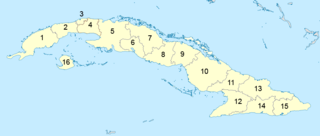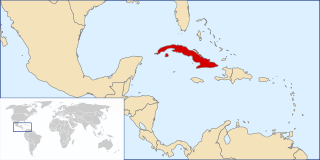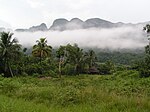
Administratively, Cuba is divided into 15 provinces and one special municipality. The current structure has been in place since August 2010, when the then-La Habana Province was divided into Artemisa Province and Mayabeque Province.

Trinidad is a town in the province of Sancti Spíritus, central Cuba. Together with the nearby Valle de los Ingenios, it has been a UNESCO World Heritage Site since 1988, because of its historical importance as a center of the sugar trade in the 18th and 19th centuries. Trinidad is one of the best-preserved cities in the Caribbean from the time when the sugar trade was the main industry in the region.

Viñales Valley is a karstic depression in Cuba. The valley has an area of 132 km2 (51 sq mi) and is located in the Sierra de los Órganos mountains, just north of Viñales in the Pinar del Río Province.

Desembarco del Granma National Park is a national park in south-western Cuba, stretching across the Niquero and Pilón municipalities in what is now Granma Province. The name of the park means "Landing of the Granma" and refers to the yacht in which Fidel Castro, Che Guevara, Raúl Castro, and 79 of their supporters sailed from Mexico to Cuba in 1956 and incited the Cuban Revolution. The National park is well known for its karst topography and coastal cliffs.
Valle de los Ingenios, also named Valley de los Ingenios or Valley of the Sugar Mills, is a series of three interconnected valleys about 12 kilometres (7.5 mi) outside of Trinidad, Cuba. The three valleys, San Luis, Santa Rosa, and Meyer, were a centre for sugar production from the late 18th century until the late 19th century. At the peak of the industry in Cuba there were over fifty sugar cane mills in operation in the three valleys, with over 30,000 slaves working in the mills and on the sugar cane plantations that surrounded them.

The Plaza Mayor in Trinidad, Cuba, is the historic centre of the town, declared a UNESCO World Heritage Site in 1988.

The following is an alphabetical list of topics related to Cuba.

Juan de la Caridad García Rodríguez is a Cuban prelate of the Catholic Church who has served as Archbishop of Havana since 26 April 2016. He previously served as an Auxiliary Bishop of Camagüey from 1997 to 2002 and then as archbishop of that diocese from 2002 to 2016. He is a past president of the Cuban Conference of Catholic Bishops. Pope Francis raised him to the rank of cardinal on 5 October 2019.
The Ingenio Engombe is located in the Santo Domingo Oeste municipality from the Santo Domingo province of the Dominican Republic. The 16th century mill was a leading regional producer of sugar, and a signifying exemplar of renaissance-era architecture for its lavish forms. A two-story mansion and a chapel remain standing on the sugar mill grounds. The site is being considered to be put on the World Heritage list of sites who have "outstanding universal value" to the world.
The World Heritage Earthen Architecture Programme (WHEAP) is a UNESCO initiative promoting earthen architecture founded in 2007 and running till 2017.




















